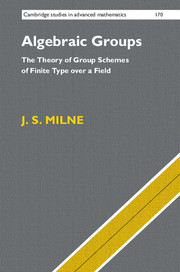Book contents
- Frontmatter
- Contents
- Preface
- Introduction
- 1 Definitions and Basic Properties
- 2 Examples and Basic Constructions
- 3 Affine Algebraic Groups and Hopf Algebras
- 4 Linear Representations of Algebraic Groups
- 5 Group Theory; the Isomorphism Theorems
- 6 Subnormal Series; Solvable and Nilpotent Algebraic Groups
- 7 Algebraic Groups Acting on Schemes
- 8 The Structure of General Algebraic Groups
- 9 Tannaka Duality; Jordan Decompositions
- 10 The Lie Algebra of an Algebraic Group
- 11 Finite Group Schemes
- 12 Groups of Multiplicative Type; Linearly Reductive Groups
- 13 Tori Acting on Schemes
- 14 Unipotent Algebraic Groups
- 15 Cohomology and Extensions
- 16 The Structure of Solvable Algebraic Groups
- 17 Borel Subgroups and Applications
- 18 The Geometry of Algebraic Groups
- 19 Semisimple and Reductive Groups
- 20 Algebraic Groups of Semisimple Rank One
- 21 Split Reductive Groups
- 22 Representations of Reductive Groups
- 23 The Isogeny and Existence Theorems
- 24 Construction of the Semisimple Groups
- 25 Additional Topics
- Appendix A Review of Algebraic Geometry
- Appendix B Existence of Quotients of Algebraic Groups
- Appendix C Root Data
- References
- Index
18 - The Geometry of Algebraic Groups
Published online by Cambridge University Press: 25 October 2017
- Frontmatter
- Contents
- Preface
- Introduction
- 1 Definitions and Basic Properties
- 2 Examples and Basic Constructions
- 3 Affine Algebraic Groups and Hopf Algebras
- 4 Linear Representations of Algebraic Groups
- 5 Group Theory; the Isomorphism Theorems
- 6 Subnormal Series; Solvable and Nilpotent Algebraic Groups
- 7 Algebraic Groups Acting on Schemes
- 8 The Structure of General Algebraic Groups
- 9 Tannaka Duality; Jordan Decompositions
- 10 The Lie Algebra of an Algebraic Group
- 11 Finite Group Schemes
- 12 Groups of Multiplicative Type; Linearly Reductive Groups
- 13 Tori Acting on Schemes
- 14 Unipotent Algebraic Groups
- 15 Cohomology and Extensions
- 16 The Structure of Solvable Algebraic Groups
- 17 Borel Subgroups and Applications
- 18 The Geometry of Algebraic Groups
- 19 Semisimple and Reductive Groups
- 20 Algebraic Groups of Semisimple Rank One
- 21 Split Reductive Groups
- 22 Representations of Reductive Groups
- 23 The Isogeny and Existence Theorems
- 24 Construction of the Semisimple Groups
- 25 Additional Topics
- Appendix A Review of Algebraic Geometry
- Appendix B Existence of Quotients of Algebraic Groups
- Appendix C Root Data
- References
- Index
Summary
In this chapter, following Iversen 1976, we show that, by using a little algebraic geometry, it is possible to prove results about algebraic groups that are normally deduced only from the classification theorems. Those unfamiliar with the theory of line bundles may skip the details. Recall that all algebraic groups are affine over a base field k.
Central and multiplicative isogenies
In this section, and G are connected group varieties. Recall (2.23, 6.6) that an isogeny is a surjective homomorphism with finite kernel. The degree of is the order of its kernel.
DEFINITION 18.1. An isogeny is central (resp. multiplicative1) if its kernel is central (resp. of multiplicative type).
A multiplicative isogeny is central by rigidity (12.38). Conversely, if is reductive, then a central isogeny is multiplicative because the centre of a reductive group is of multiplicative type (17.62).
An isogeny of degree prime to the characteristic has étale kernel (11.31), and so it is central (12.39). In nonzero characteristic, there exist noncentral isogenies, for example, the Frobenius map (2.24). The isogenies in nonzero characteristic that behave as the isogenies in characteristic zero are the multiplicative isogenies.
PROPOSITION 18.2. A composite of multiplicative isogenies is multiplicative.
PROOF. Let and
be composable multiplicative isogenies. Then
is exact (Exercise 5-8). Corollary 12.41 shows that Ker is central, and hence of multiplicative type (12.22).
EXAMPLE 18.3. Let k be a field of characteristic 2. Let be the group variety attached to the quadratic form
on and that attached to the skew-symmetric form on. These are semisimple algebraic groups, and the diagonal tori in each are split maximal tori. The group G fixes the basis vector e0 in (only because the characteristic is 2) and hence acts on. From this isomorphism, we get an isogeny from G to that restricts to an isomorphism on the diagonal maximal tori. It is not central because the centre of a reductive group is contained in every maximal torus (because of 17.84).
- Type
- Chapter
- Information
- Algebraic GroupsThe Theory of Group Schemes of Finite Type over a Field, pp. 387 - 396Publisher: Cambridge University PressPrint publication year: 2017



